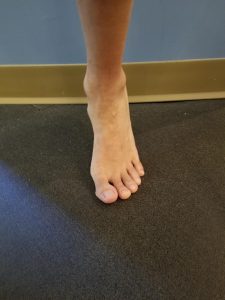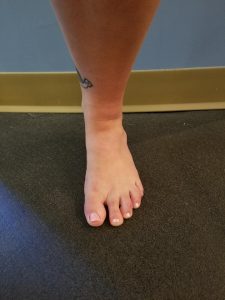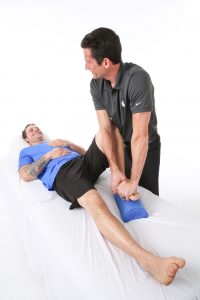Some people think that pronation is bad. Pronation is a necessary motion that allows the foot to accommodate to the ground in a way that ideally reinforces stability and allows for a broad transference of force through the entire foot. It isn’t a bad thing. A lack of pronation can be just as detrimental as an excessive amount of pronation.
An efficient foot is structurally capable of pronating to accommodate the foot to the ground and supinating to effectively push off of the ground. Pronation occurs during normal weight-bearing activities. Pronation begins in, but must not be isolated to, the rearfoot (back 1/3 of foot). It must continue as a spreading of the midfoot (middle 1/3 of foot) and forefoot (front 1/3 of foot) joints. An efficient foot is a foot that is broad, elastic, and capable of equal weight-bearing between the front and back and the sides of each foot. It is not rigid.
The primary foot dysfunction that we see in our practice is severe stiffness of the mid-foot joints (the joints between the heel and the toes). This is true in people who have a high arch foot posture (‘supinated foot’) or a low arch foot posture (‘pronated foot’). This stiffness limits pronation in the mid-foot and leads to three negative compensations:
- Excessive rearfoot pronation
- Poor timing of pronation
- Increased rate of pronation
Excessive Rearfoot Pronation

Rear-foot pronation back view
Many people over-pronate through their rearfoot when they stand, walk, and run. This means they tend to utilize a greater amount of their overall pronation range of motion compared ‘normal’. Again, this over-pronation is typically associated with rigidity of the midfoot joints. This rigidity disallows the splay/spreading of pronation into the mid and forefoot and forces the rearfoot structures to take on more of the force. This compensatory over-pronation of the rearfoot causes increased internal rotation up the leg into the knee and hip. This is why the feet need to be considered as a possible culprit in knee, hip, or back pain.
Quick Test: In normal standing posture, do you feel more weight on the inside or outside of your heel? If you feel more weight on the inside of your heel, you are likely in an over-pronated rearfoot position. If you feel more weight on the outside of your heel you are likely standing in an over-supinated rearfoot position. You should feel equal weight between the inside and outside of your heel.
Poor Timing of Pronation
Another common dysfunction is poor timing of pronation (or ‘pronating at the wrong time’). In order to effectively propel ourselves forward while walking and running, the foot must stop pronating and move into a position of supination as we push off of our foot. Supination provides a more stable structure to transfer the force created by our muscles into the ground. Poor timing of pronation refers to pronation that is occurring while we are pushing off. This results in wasted energy and tremendous strain on structures that are meant to help stabilize the medial longitudinal arch of the foot (such as the plantar fascia, plantar ligaments, and posterior tibialis muscle).

Pronated rear-foot during push-off (note the ‘bulge’ of the navicular on the medial aspect of the foot)

Re-supinated rear-foot during push-off (note the essentially straight line along the medial aspect of the foot)
Quick Test: Have someone video you from behind as you walk. Note the position of your Achilles tendon and heel as your foot

Efficient re-supination of rear-foot
leaves the ground. A line going through your Achilles and heel should be vertical or angled slightly down and in. If your line is angled down and out this means your rearfoot is still in a position of pronation while you are pushing off.
Increased Rate of Pronation
Lastly, there is the problem of pronating too quickly (due to rigidity of the midfoot and/or a lack of neuromuscular control). One scientific study demonstrated that injured runners tend to pronate about twice as fast as non-injured runners. This places a greater demand on the muscles and joints of the foot and lower leg. The injured runners in this study suffered from knee pain – again demonstrating the effect of foot function on more than just the foot.
Game Plan
If you are a client of IPA Physio or have been treated by a Functional Manual Therapist, then you know we evaluate pain and dysfunction based on mechanical factors, neuromuscular factors, and motor control factors. For more information on our treatment paradigm, click here.
If you tested positive on one or both quick tests above, read this blog to learn what you can do to modify your habit patterns and improve the stability of your foot. The information provided in this article will help you enhance your neuromuscular capacity and motor control. However, in order to address the mechanical factors, it is best to seek treatment from a Functional Manual Therapist.

Over-pronation is an example of too much movement in one direction. Too much movement somewhere is often caused by too little movement somewhere else, or an inability to move in the opposite direction. We’ve discussed the fact that rigidity (too little movement) of the midfoot is a major cause of over-pronation (too much movement) of the rearfoot. Therefore, it is of utmost importance to re-instate optimal mobility to the midfoot in order to enhance neuromuscular control of the rearfoot. Likewise, it is important to evaluate the ability of the joints of the rearfoot to move into a position of supination from a mechanical standpoint, as they are often limited in their ability to do so.
Lastly, for those of you that passed the quick tests, and for those of you who know that your problem is an inability to pronate effectively – this is a mechanical problem of rigidity in your rearfoot and midfoot. If this describes you and you are experiencing pain in your foot or lower body, the problem is a lack of shock absorption in your foot leading to excessive force transfer into the lower leg, knee, hip, and spine. I will address these factors in a subsequent blog post.
In summary, it is important to have a balance of stability and mobility through the foot (and throughout the body for that matter). Pronation is necessary but must be dispersed throughout the foot. It is important to enhance the mobility of areas of the foot that are rigid, through soft tissue mobilization and joint mobilization. It is equally important to improve the neuromuscular control of the areas of the foot that over-pronate, through corrective exercises and motor control training.
References:
Hosl M, Bohm H, et al. Does excessive flatfoot deformity affect function? A comparison between symptomatic and asymptomatic flatfeet using the Oxford Foot Model. Gait and Posture 2013
Rodrigues P, TenBroek T. Evaluating runners with and without anterior knee pain using the time to contact the joint complexes’ range of motion boundary. Gait and Posture 2013
Rodrigues PA, TenBroek T, Hamill J. Runners with anterior knee pain utilize a greater percentage of their available pronation range of motion. Journal of Applied Biomechanics 2013;29(April (2)):141–6






